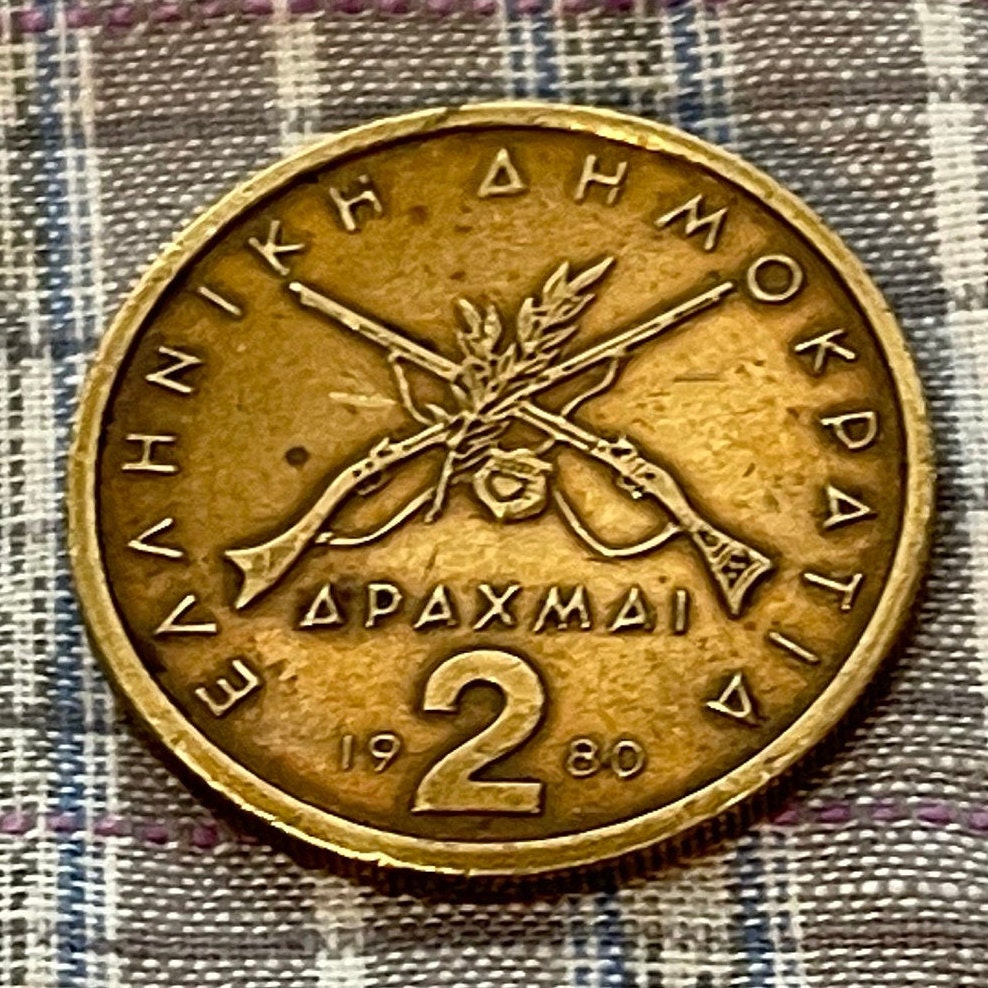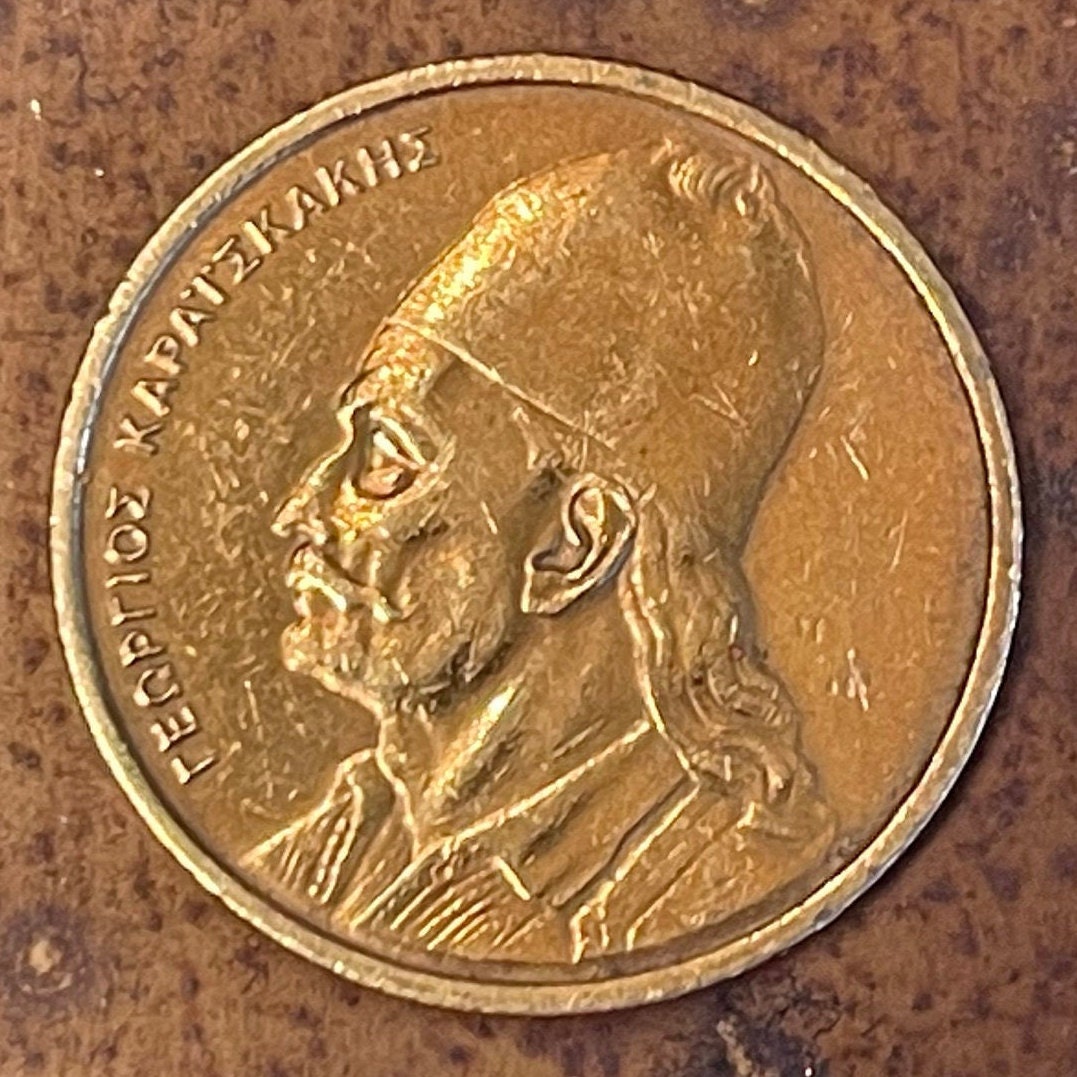elemintalshop
Georgios Karaiskakis & Karyophile Muskets 2 Drachmes Greece Authentic Coin Money for Jewelry (Greek Independence) (Vasiliki) (Rifles)
Georgios Karaiskakis & Karyophile Muskets 2 Drachmes Greece Authentic Coin Money for Jewelry (Greek Independence) (Vasiliki) (Rifles)
Couldn't load pickup availability
Georgios Karaiskakis & Crossed Karyophile Muskets 2 Drachmes Greece Authentic Coin Money for Jewelry and Craft Making (Greek Independence)(Vasiliki) (Crossed Rifles) (Rifle of '21) (Greek Revolution of 1821)
Obverse: The portrait in left profile of Georgios Karaiskakis (1782-1827), a famous Greek klepht [bandit], armatolos, military commander, and a hero of the Greek War of Independence
Lettering: ΓΕΩΡΓΙΟΣ ΚΑΡΑΙΣΚΑΚΗΣ
Translation: GEORGIOS KARAISKAKIS
Reverse: Two crossed Karyophile muskets, with branch, denomination and date below. Georgios Karaiskasis named his personal Karyophile musket, "Vasiliki".
Lettering: ΕΛΛΗΝΙΚΗ ΔΗΜΟΚΡΑΤΙΑ
2 ΔΡΑΧΜΕΣ
1982
Translation: HELLENIC REPUBLIC
2 DRACHMES
1982
Features
Issuer Greece
Period Third Hellenic Republic (1974-date)
Type Standard circulation coin
Years 1982-1986
Value 2 Drachmes (2 GRD)
Currency Third modern drachma (1954-2001)
Composition Nickel brass
Weight 6.0 g
Diameter 24 mm
Thickness 1.77 mm
Shape Round
Orientation Medal alignment ↑↑
Demonetized 02-28-2002
Number N# 549
References KM# 130, Schön# 83
Wikipedia:
Georgios Karaiskakis (Greek: Γεώργιος Καραϊσκάκης), born Georgios Karaiskos (Greek: Γεώργιος Καραΐσκος; 1782 – April 23, 1827), was a famous Greek military commander and a leader of the Greek War of Independence.
Early life
Karaiskakis was born in 1782 in a monastery near the village of Skoulikaria (Greek: Σκουληκαριά) close to Arta. His father was the armatolos of the Valtos district, Dimitris Iskos or Karaiskos, his mother Zoe Dimiski (from Arta, Greece, who was also the niece of a local monastery abbot) and cousin of Gogos Bakolas, captain of the armatoliki of Radovitsi. He was of Sarakatsani descent. At an very early age he became a klepht in the service of Katsantonis, a famous local Agrafiote brigand captain. He excelled as a klepht [bandit] — agile, cunning, brave and reckless — and rose quickly through the ranks, eventually becoming a protopalikaro, or lieutenant.
At the age of fifteen he was captured by the troops of the Albanian ruler Ali Pasha and imprisoned at Ioannina, where close to Ali Pasha he learned Albanian. Ali Pasha, impressed by Karaiskakis’s courage and intelligence, and sensing his worth as a fighter, released him from prison and put him in the care of his personal bodyguards. He served as a bodyguard to Ali Pasha for a few years. During his service under Ali Pasha, he fought against another Ottoman warlord, Osman Pazvantoğlu, in 1798.
Karaiskakis served in the army of Ali Pasha in his war against the Ottomans, but after the defeat and death of the ruler of Ioannina, Karaiskakis fled to Vonitsa.
In July 1821 he took part with the Greek rebels in the Battle of Komboti against Pliasa Ismail Pasha, but he soon left to pursue his long-held ambition of seizing the armatolik of Agrafa, then held by the family of Ioannis Boukouvalas. Karaiskakis gathered supporters from Valtos and other areas, and was joined by Yannakis Rangos. In this way, he was able to take over Agrafa and was recognized as holder of the armatolik not only by the local captains, but also by the Ottoman authorities, who were too busy with suppressing the Greek uprising in the Morea (Peloponnese).
Despite his recognition by the Ottomans, he attacked the Ottoman army retreating from the failed First Siege of Missolonghi in early 1823, defeating a 3,000-strong detachment that tried to cross the Agrafa area at the pass of Agios Vlasios. When Mustafa Pasha Bushatli, the Pasha of Scutari, arrived at Larissa in 1823, he ordered Karaiskakis to come before him and reaffirm his loyalty in person, rather than through a representative as was usual. Instead, Karaiskakis although heavily ill, left Agrafa with about 300 men and made for Prousos Monastery. There he stayed to recuperate, while his men joined Markos Botsaris' Souliotes, and eventually fought with them in the Battle of Karpenisi. As his health did not improve, Karaiskakis left for Ithaca, then ruled by the British, to consult physicians there. In his absence, Yannakis Rangos declared himself as leader of Karaiskakis' men.
Karaiskakis's reputation grew during the middle and latter stages of the war. He helped to lift the second siege of Missolonghi in 1823, and did his best to save the town from its third siege in 1826.
That same year (1826), he was appointed commander-in-chief of the Greek revolutionary forces in Rumeli, achieving a mixed response: while failing to cooperate effectively with other leaders of the independence movement or with the foreign sympathizers fighting alongside the Greeks, he gained some military successes against the Ottomans.
His most famous victory was at Arachova, where his army together with other revolutionary leaders, crushed a force of Turkish and Albanian troops under Mustafa Bey and Kehaya Bey. Victories such as the one at Arachova were especially welcome amid the disasters that were occurring elsewhere.
In 1827, Karaiskakis participated in the failed attempt to raise the siege of Athens, and attempted to prevent the massacre of the Ottoman garrison stationed in the convent of Saint Spyridon in Piraeus.
He was killed in action on his Greek name day, 23 April 1827, after being fatally wounded by a rifle bullet during the Battle of Phaleron. According to Karaiskakis's expressed desire to be buried on the island of Salamis when he died, he was buried at the church of Saint Dimitrios on Salamis.
King Otto of Greece posthumously conferred Karaiskakis the Grand Cross of the Order of the Redeemer.
Karaiskakis was famous among the fighters of the revolution for his tirade manner of speaking.
Karaiskaki Stadium in Neo Faliro, Piraeus is named after him as he was mortally wounded in the area.
Dionysis Savvopoulos has written both music and lyrics to the popular Greek song "Ode to Georgios Karaiskakis" (Greek: "Ωδή στο Γεώργιο Καραϊσκάκη"). Savvopoulos wrote the song for Che Guevara, but he chose this title to pass the censorship of the Greek military junta.
*********
For the fighters of the Greek Revolution of 1821, their weapons were not only the defense and attack against the enemy, their companion in battle and their friend in the few moments of rest in the steep mountains and plains. It was much more than that ... It was their means to freedom, their means to shake off the Turkish yoke.
Weapons were usually passed from father to son, from comrade-in-arms to comrade-in-arms, but often they were booty that the Greek fighters could wrest from the Turks, and others came from donations from Philhellenic committees. The weapon was the most valuable item of the soldier. It was usually not simple in appearance and was decorated with motifs from folk tradition and antiquity, Byzantium and the Christian religion.
Karyophile: It is the famous rifle of '21, which was used rather synthetically. It was one of the main weapons of combat in the Greek Revolution of 1821 Its barrel was long, iron and cylindrical, while in the handle of the weapon there was a ring for the strap. The special place the rifle occupied in the Greek arsenal is shown by the fact that its owners often named it. Athanasios Diakos called it "papadia", Karaiskakis "Vasiliki", Dimitrios Makris "Liaro".
Source: https://www.greecehighdefinition.com/blog/2021/3/19/revolution-1821-the-weapons-of-struggle-for-freedom-photo-video
Share










Very happy with this purchase!
Excellent as always, thank you









